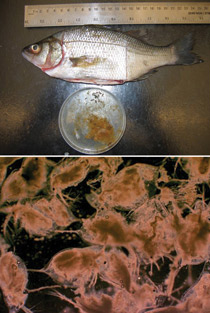Plankton

Phytoplankton and zooplankton form the base of Lake Champlain’s food web, sometimes called the ‘lower food web.’ These microscopic floating plants, animals, and bacteria are the most numerous and most simple organisms. Complex predator-prey relationships lead to the top of the food web—predator fish such as largemouth bass, northern pike, lake trout, and salmon, and the people and animals that fish for these species. Aquatic insects and forage fish, such as smelt and minnows, link the plankton community and the predator fish. Also, most fish, including predatory fish, feed directly on the plankton community when they are young.
Plankton communities are dynamic and strongly influenced by changes in their physical environment (often referred to as ‘bottom-up’ effects). Phytoplankton are microscopic plants that grow by photosynthesis, requiring sunlight and nutrients, including phosphorus. In environments where there is excess phosphorus, phytoplankton, or algae, may grow abundantly. This can lead to algal blooms and is one of the reasons our water resource management efforts are focused on reducing phosphorus.
Other environmental factors, such as temperature, also can influence phytoplankton growth. Cyanobacteria (blue-green algae), for example, prefer warmer water. With the increased temperatures predicted for the future, this could mean more cyanobacteria blooms. Warmer summer days coupled with increasing phosphorus concentrations may contribute to increasing number of blooms throughout the Lake.
Zooplankton are the “animal” brethren of phytoplankton. They are tiny, single-celled organisms that prey on phytoplankton, smaller zooplankton, or detritus in the water column. Zooplankton also respond to bottom-up effects—fewer phytoplankton means less food, and changes in the type of phytoplankton may mean less good food is available for certain species of zooplankton. This, in turn, affects the fish that eat the zooplankton and so on up the food chain to the largest predators in the lake, such as Atlantic salmon and lake trout. ‘Top-down’ effects, such as changes in the predators that eat zooplankton, also can be very important. For example, large populations of zooplankton-eating fish will reduce zooplankton populations, which will result in less predation pressure on algae (phytoplankton). As a result, water clarity may decrease or more algal blooms may occur.
Changes in the Lake Champlain ecosystem caused by invasive species have affected plankton communities. Filter-feeding invasive zebra mussels consume large quantities of select plankton species, which has led to an increase in lake water clarity in shallow water and alters the food supply for fish and zooplankton that prefer these species as a food source. However, zebra mussels do not eat cyanobacteria, the plankton that cause the harmful algae blooms common in some parts of Lake Champlain. The reduced competition for available nutrients and sunlight allows for cyanobacteria to flourish and bloom more frequently. Spiny water flea and fishhook water flea—invasive zooplankton found in Lake Champlain in 2014 and 2018 respectively—have the potential to disrupt the plankton communities in Lake Champlain by eating or outcompeting other plankton, potentially affecting the entire food web.
Plankton Monitoring in Lake Champlain
Researchers at several academic institutions and State and Provincial agencies in the region are working to increase our understanding of this broad group of plants and animals. The Long-Term Water Quality and Biological Monitoring Project for Lake Champlain (LTMP) includes monitoring of plankton at 15 lake stations between April and October each year. Monitoring program staff count and identify phytoplankton and zooplankton at each of these stations. The Lake Champlain Research Institute at SUNY Plattsburgh, with funding from LCBP as part of the LTMP, has documented several shifts in the plankton community over the past few decades as new invasive species arrive and flourish in Lake Champlain and others decline. Continued monitoring and research on this important part of the Lake Champlain ecosystem is critical to understanding and predicting changes to the ecosystem as new species arrive, others decline, and our climate changes. To learn more about this program and view data, visit the LTMP website and view the “Biological Data Graphs” in the right column.
Phytoplankton ID Guides
- Pictorial Guide to Common Phytoplankton of Lake Champlain and the Lower Great Lakes (University of Vermont)
- Freshwater Plankton (Connecticut College)
- Great Lakes Water Life Photo Gallery: Great Lakes Algae (Great Lakes Environmental Research Lab)
Zooplankton ID Guides
- An Image-Based Key To The Zooplankton Of The Northeast USA (University of New Hampshire)
- Free-living and Parasitic Copepods of the Laurentian Great Lakes: Keys and Details on Individual Species (Great Lakes Science Center)
- Great Lakes Water Life Photo Gallery: Crustacean Zooplankton and Rotifers (Great Lakes Environmental Research Lab)
More on Plankton
For more information on how the Lake Champlain food web—including plankton—is changing, please visit our State of the Lake website.
